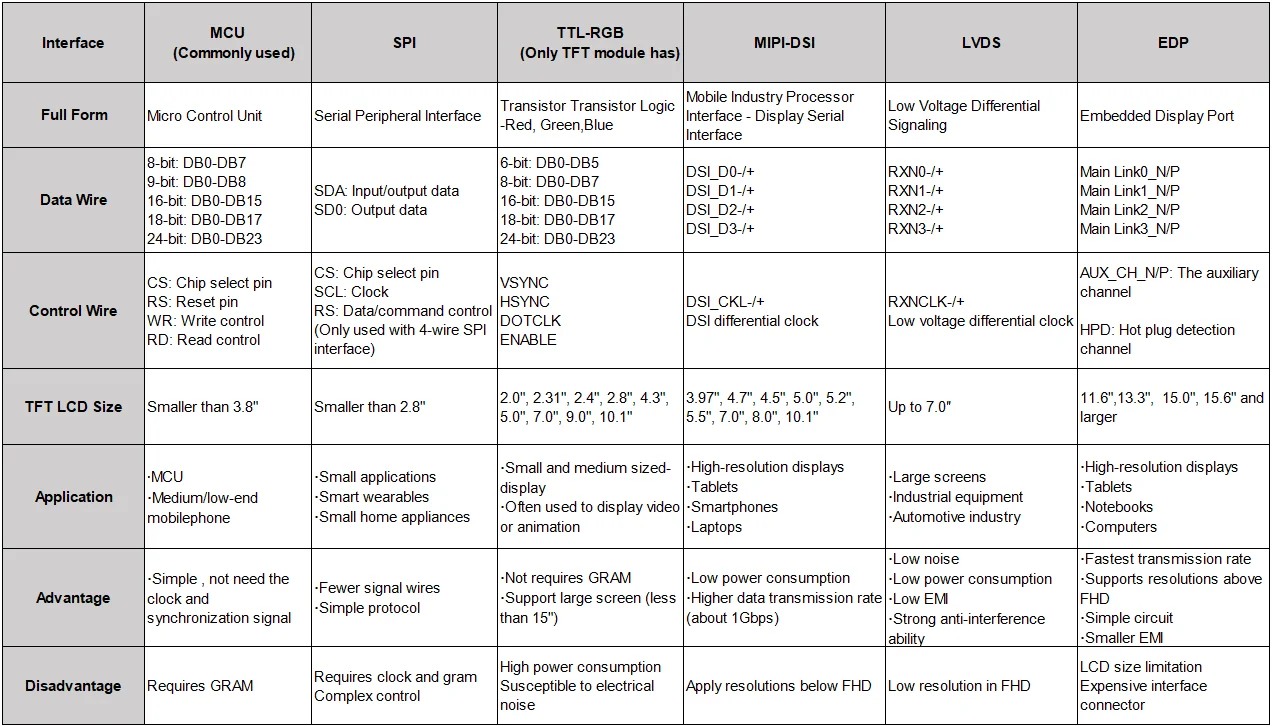
LCD Display(Liquid Crystal Display) is a widely used display technology in consumer electronics, industrial control, automotive, and more.
Based on functionality and interface type, LCDs are generally classified into:
Monochrome LCDs (Segment or Dot Matrix)
LCD Display with Touch Screens (Capacitive/Resistive)
Commonly used in TFT LCD Module, character lcd display, and graphic LCDs
Signal lines: D0–D7 / D0–D15 + control signals (RS, WR, RD, CS, RST)
Advantage: High-speed transmission
Disadvantage: Occupies many MCU pins
Suitable for small TFT lcds, OLED displays, and character LCD displays
SPI: SCLK, MOSI, MISO, CS
I2C: SCL, SDA
Advantages: Fewer pins, easier wiring
Disadvantages: Slower speed compared to parallel
Used in medium-to-large TFT LCDs (typically 4.3" and above)
Signals: RGB data lines (R, G, B), sync lines (HSYNC, VSYNC), DE, PCLK
Advantages: Real-time image display, high color quality
Disadvantages: Requires high-performance controller
Found in high-resolution LCD Displays (smartphones, tablets)
High-speed serial interface
Disadvantages: Requires application processor or special controller; not MCU-compatible
Used in laptops, monitors, and industrial panels
Differential signal transmission for better EMI performance
Disadvantages: Requires dedicated driver board or motherboard
Connection Type |
Advantages |
Disadvantages |
FPC + ZIF connector |
Compact, mass production friendly |
Slightly more costly |
Pin header soldering |
Low cost, easy for prototyping |
Not ideal for mass assembly |
Zebra strip |
Ultra-thin, clean appearance |
High assembly precision required |
Module package |
Plug-and-play |
Higher cost |
Voltage compatibility (3.3V vs 5V)
Initialization timing based on controller datasheet
Wiring guidelines: short, direct, and shielded if possible
Power stability: include decoupling capacitors and proper grounding
Touch panel handling (I2C or USB interface)
Application |
Display Type |
Interface |
Control Method |
STM32 Dev Board |
1.8 TFT (ST7735S) |
SPI |
HAL driver or screen lib |
Industrial Terminal |
7 TFT + CTP |
RGB + I2C |
Linux framebuffer |
Instruments |
Segment LCD |
GPIO Direct |
Custom MCU code |
Smart Band |
OLED (SSD1306) |
I2C |
Arduino driver library |
Choose the LCD interface based on size, resolution, controller capabilities, product structure, and performance needs.
For prototyping, SPI/I2C lcd displays are easier to handle.
For final products, consider RGB, LVDS, or MIPI depending on display performance requirements.
The 8 inch displays might be affected and delay for an accident.
This is the project management of how sinocrystal handle your customized project relate to displays.
New iPhone 13 Series will use On-Cell OLED Displays. And it that will be launched in the second half of this year will be exclusively supplied by Samsung Display (SDC)
A complete guide to LCD display connection methods, including SPI, I2C, RGB, MIPI, LVDS interfaces and physical mounting options. Learn how to connect monochrome and TFT LCDs to your development board or product housing.
This week, we had the pleasure of hosting an esteemed international client at our LCD display manufacturing facility in Dongguan. Guided by our team, the client visited key production areas such as the fully automated COG bonding line, backlight assembly area, full lamination workshop, and final product aging test section. They highly appreciated our production capacity, strict quality control, and engineering expertise. This visit strengthened mutual trust and set the stage for future collabora
The ILI9881C is a high-performance a-Si TFT LCD single-chip driver developed by ILI Technology Corp. With its excellent display performance and flexible configuration options, this driver meets the modern display device requirements for high resolution and color accuracy. This article will detail the supported resolutions, interfaces, and power supply voltage of the ILI9881C.
The GC9307, a TFT LCD driver with QVGA resolution, has gained widespread use among LCD module manufacturers since its launch. Sinocrystal are excited to share a series of practical insights we have gathered from using the GC9307 driver.